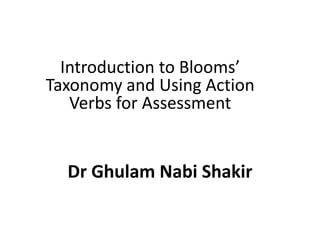blooms' taxonomy of behavioral objectives.pptx
•Download as PPTX, PDF•
0 likes•9 views
abc
Report
Share
Report
Share

Recommended
More Related Content
Similar to blooms' taxonomy of behavioral objectives.pptx
Similar to blooms' taxonomy of behavioral objectives.pptx (20)
Teaching Higher Order Thinking & 21st Century Skills

Teaching Higher Order Thinking & 21st Century Skills
General Framework for Setting Examination Papers and Test Papers

General Framework for Setting Examination Papers and Test Papers
(ED 211 Advance Educational Psychology ) KRISTELE JOY B. RARALIO Reporter DR....

(ED 211 Advance Educational Psychology ) KRISTELE JOY B. RARALIO Reporter DR....
ERA-Introduction_to_concepts_of_Taxonomy -16-12-14.ppt

ERA-Introduction_to_concepts_of_Taxonomy -16-12-14.ppt
Intended Learning Outcomes and Students Assessment

Intended Learning Outcomes and Students Assessment
2 Writing Behavioral Objectives Taxonomy of educational objectives (2).pdf

2 Writing Behavioral Objectives Taxonomy of educational objectives (2).pdf
More from ghulamnabishakir
More from ghulamnabishakir (10)
organogram of departments in education in pakistan

organogram of departments in education in pakistan
Recently uploaded
https://app.box.com/s/h5mhqoyabotgw05s0df0ltw3e39pgnmyTỔNG HỢP HƠN 100 ĐỀ THI THỬ TỐT NGHIỆP THPT TOÁN 2024 - TỪ CÁC TRƯỜNG, TRƯỜNG...

TỔNG HỢP HƠN 100 ĐỀ THI THỬ TỐT NGHIỆP THPT TOÁN 2024 - TỪ CÁC TRƯỜNG, TRƯỜNG...Nguyen Thanh Tu Collection
https://app.box.com/s/z2cfx5b2yooxq1ov1wrd1dezn6af36uxBỘ LUYỆN NGHE TIẾNG ANH 8 GLOBAL SUCCESS CẢ NĂM (GỒM 12 UNITS, MỖI UNIT GỒM 3...

BỘ LUYỆN NGHE TIẾNG ANH 8 GLOBAL SUCCESS CẢ NĂM (GỒM 12 UNITS, MỖI UNIT GỒM 3...Nguyen Thanh Tu Collection
This presentation was provided by William Mattingly of the Smithsonian Institution, during the fifth segment of the NISO training series "AI & Prompt Design." Session Five: Named Entity Recognition with LLMs, was held on May 2, 2024.Mattingly "AI & Prompt Design: Named Entity Recognition"

Mattingly "AI & Prompt Design: Named Entity Recognition"National Information Standards Organization (NISO)
Recently uploaded (20)
The Story of Village Palampur Class 9 Free Study Material PDF

The Story of Village Palampur Class 9 Free Study Material PDF
TỔNG HỢP HƠN 100 ĐỀ THI THỬ TỐT NGHIỆP THPT TOÁN 2024 - TỪ CÁC TRƯỜNG, TRƯỜNG...

TỔNG HỢP HƠN 100 ĐỀ THI THỬ TỐT NGHIỆP THPT TOÁN 2024 - TỪ CÁC TRƯỜNG, TRƯỜNG...
Analyzing and resolving a communication crisis in Dhaka textiles LTD.pptx

Analyzing and resolving a communication crisis in Dhaka textiles LTD.pptx
How to Send Pro Forma Invoice to Your Customers in Odoo 17

How to Send Pro Forma Invoice to Your Customers in Odoo 17
Trauma-Informed Leadership - Five Practical Principles

Trauma-Informed Leadership - Five Practical Principles
PSYPACT- Practicing Over State Lines May 2024.pptx

PSYPACT- Practicing Over State Lines May 2024.pptx
Andreas Schleicher presents at the launch of What does child empowerment mean...

Andreas Schleicher presents at the launch of What does child empowerment mean...
BỘ LUYỆN NGHE TIẾNG ANH 8 GLOBAL SUCCESS CẢ NĂM (GỒM 12 UNITS, MỖI UNIT GỒM 3...

BỘ LUYỆN NGHE TIẾNG ANH 8 GLOBAL SUCCESS CẢ NĂM (GỒM 12 UNITS, MỖI UNIT GỒM 3...
Sternal Fractures & Dislocations - EMGuidewire Radiology Reading Room

Sternal Fractures & Dislocations - EMGuidewire Radiology Reading Room
Basic Civil Engineering notes on Transportation Engineering & Modes of Transport

Basic Civil Engineering notes on Transportation Engineering & Modes of Transport
Mattingly "AI & Prompt Design: Named Entity Recognition"

Mattingly "AI & Prompt Design: Named Entity Recognition"
blooms' taxonomy of behavioral objectives.pptx
- 1. Dr Ghulam Nabi Shakir Introduction to Blooms’ Taxonomy and Using Action Verbs for Assessment
- 2. What is Bloom's taxonomy? Bloom's taxonomy was developed by a group of educational psychologists in the 1950s, led by Benjamin Bloom. They identified six categories of cognitive skills, from the simplest to the most complex: knowledge, comprehension, application, analysis, synthesis, and evaluation. Each category represents a different level of thinking that learners can demonstrate in response to a learning task. The higher the level, the more challenging and creative the task requires.
- 3. What is Bloom's taxonomy? One of the main applications of Bloom's taxonomy is to create learning objectives that align with the level of thinking you want your learners to achieve. To use Bloom's taxonomy for creating learning objectives, you can identify the overall goal or outcome of your training, choose the appropriate level of Bloom's taxonomy that matches the complexity and depth of your goal, and use verbs that correspond to the chosen level of Bloom's taxonomy to write your learning objectives.
- 4. What is Bloom's taxonomy? Additionally, make sure your learning objectives are specific, measurable, achievable, relevant, and time-bound (SMART). For example, a SMART learning objective for the application level might be: By the end of this training, learners will be able to apply the principles of effective communication to create a persuasive presentation. This will provide a clear direction and purpose for your training design and evaluation.
- 6. NEW APPROACH Anderson and Krathwohl redefine the knowledge dimension to include four types: • Factual Knowledge: Basic elements of a discipline that a student must know and be able to work with to solve problems including basic terminology and specific details and elements. • Conceptual Knowledge: Interrelationships between basic factual knowledge that demonstrate how elements work together, for example, classifications and categories, principles and generalizations, and theories, models, and structures. • Procedural Knowledge: How something is done including the methods of inquiry, skills, algorithms, techniques, and methods needed to investigate, apply, or analyze information. • Metacognitive Knowledge: Awareness and knowledge of one’s own cognition including strategies for learning, contextual and conditional knowledge about cognitive tasks, and self-knowledge.